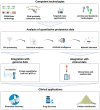Towards Building a Quantitative Proteomics Toolbox in Precision Medicine: A Mini-Review
- PMID: 34512391
- PMCID: PMC8427610
- DOI: 10.3389/fphys.2021.723510
Towards Building a Quantitative Proteomics Toolbox in Precision Medicine: A Mini-Review
Abstract
Precision medicine as a framework for disease diagnosis, treatment, and prevention at the molecular level has entered clinical practice. From the start, genetics has been an indispensable tool to understand and stratify the biology of chronic and complex diseases in precision medicine. However, with the advances in biomedical and omics technologies, quantitative proteomics is emerging as a powerful technology complementing genetics. Quantitative proteomics provide insight about the dynamic behaviour of proteins as they represent intermediate phenotypes. They provide direct biological insights into physiological patterns, while genetics accounting for baseline characteristics. Additionally, it opens a wide range of applications in clinical diagnostics, treatment stratification, and drug discovery. In this mini-review, we discuss the current status of quantitative proteomics in precision medicine including the available technologies and common methods to analyze quantitative proteomics data. Furthermore, we highlight the current challenges to put quantitative proteomics into clinical settings and provide a perspective to integrate proteomics data with genomics data for future applications in precision medicine.
Keywords: bioinformatics; biomarker discovery; clinical diagnostics; precision medicine; protein quantitative trait loci; quantitative proteomics; targeted techniques.
Copyright © 2021 Correa Rojo, Heylen, Aerts, Thas, Hooyberghs, Ertaylan and Valkenborg.
Conflict of interest statement
The authors declare that the research was conducted in the absence of any commercial or financial relationships that could be construed as a potential conflict of interest.
Figures

References
Publication types
LinkOut - more resources
Full Text Sources
Medical

